Industrial Casters Play an Important Role in Industry
Industrial casters play a pivotal role in diverse industries, quietly supporting the smooth and efficient movement of heavy loads and equipment. These unassuming wheels are the unsung heroes behind the scenes, making material handling and transportation more manageable and safer. From warehouses to manufacturing plants, hospitals to airports, and virtually every industry in between, industrial casters are indispensable components that keep operations rolling.
The choice of the right caster type is not a matter of mere preference; it is a critical decision that directly impacts productivity, safety, and overall performance. Each industry has unique demands, and the loads being transported vary greatly in weight and size. Selecting the appropriate caster is akin to finding the perfect balance between functionality, durability, and maneuverability.
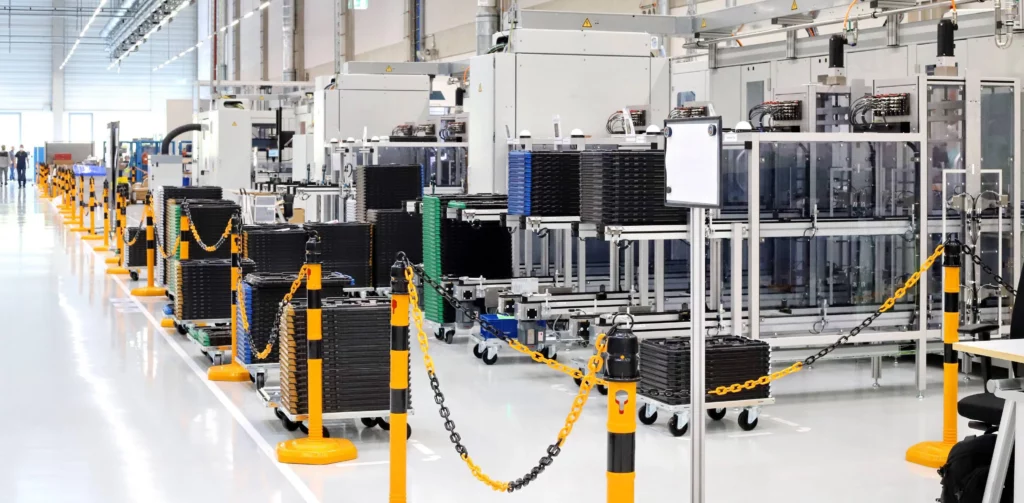
In this comprehensive guide, we will delve into the world of industrial casters, exploring their various types and applications. Whether it’s light-duty casters, medium-duty casters, heavy-duty casters, or super heavy-duty casters, understanding their strengths and limitations is key to optimizing workflow efficiency and ensuring the well-being of workers.
What are Industrial Casters?
Industrial casters are specialized wheels mounted on a frame, designed to facilitate the movement of heavy loads and equipment in industrial settings. They are versatile components, capable of navigating a wide range of environments, from smooth factory floors to rugged outdoor terrains. These unassuming wheels come in various types, each tailored to meet specific load capacities and operational requirements.
A. Primary Function in Material Handling and Transportation:
The primary function of industrial casters is to enable smooth and effortless movement of heavy objects, reducing the need for manual lifting and carrying. By attaching casters to carts, trolleys, racks, and other mobile structures, industrial workers can transport substantial loads with ease, significantly streamlining material handling processes.
B. Enhancing Mobility, Efficiency, and Safety in Industrial Settings:
1. Mobility: Industrial casters provide exceptional maneuverability, allowing workers to transport goods swiftly and efficiently. The ability to rotate 360 degrees (in the case of swivel casters) and change direction on the spot makes navigating tight spaces and congested areas a breeze.
2. Efficiency: With the right caster type, industrial operations can witness a boost in productivity. Workers can move heavy items with minimal effort, reducing fatigue and increasing overall workflow efficiency. This means faster turnaround times, optimized processes, and ultimately, improved business outcomes.
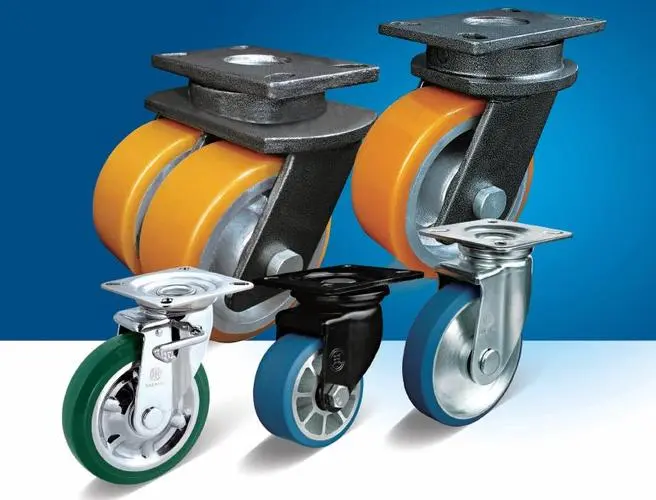
3. Safety: Safety is paramount in industrial environments, and industrial casters play a crucial role in ensuring it. By easing the movement of heavy loads, casters minimize the risk of musculoskeletal injuries and strain-related accidents that may occur when attempting to lift and carry heavy objects manually.
4. Floor Protection: Industrial casters are designed to be gentle on the flooring, preventing damage and preserving the integrity of the workspace. Depending on the wheel material, casters can handle various floor types, including concrete, tile, carpet, and hardwood.
5. Customization: The versatility of industrial casters allows for customization to suit specific applications. Whether it’s choosing the right wheel material, brake system, or load capacity, tailoring casters to the unique needs of an industrial setting ensures optimal performance and longevity.
Industrial casters are silent heroes that significantly contribute to the smooth operation of various industries. Their ability to enhance mobility, efficiency, and safety while accommodating diverse loads makes them essential tools for material handling and transportation tasks.
Components of Industrial Casters
Industrial casters are intricate systems composed of several components working together to facilitate the smooth and efficient movement of heavy loads in industrial settings. These components are carefully designed and assembled to ensure durability, versatility, and ease of use. The primary components of industrial casters include:
1. Wheel: The wheel is the central component of the caster that comes into direct contact with the floor surface. It is responsible for carrying the load and enabling smooth movement. Industrial caster wheels come in various materials, such as rubber, polyurethane, nylon, and steel, each offering specific characteristics suited for different applications.
2. Bearing: Bearings are critical components that reduce friction between the wheel and the caster’s axle, allowing for easy rotation and smooth movement. Common bearing types used in industrial casters include roller bearings and ball bearings.
3. Mounting Plate: The mounting plate is the platform on which the caster is attached to the object or equipment that requires mobility. It typically has holes or slots for screws or bolts to secure the caster in place.
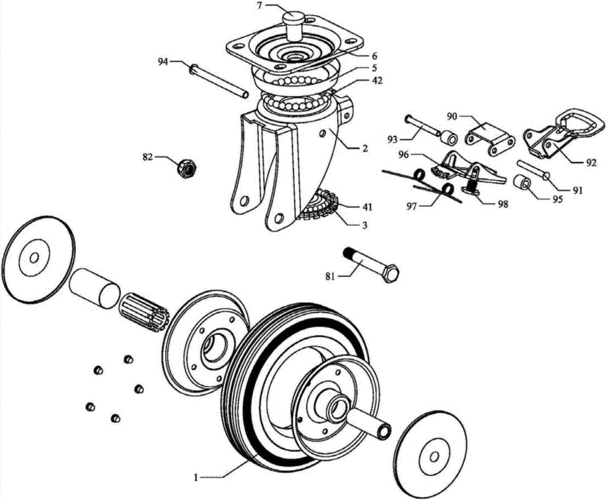
4. Swivel Lock and Brake: Many swivel casters come with a swivel lock and brake mechanism. The swivel lock allows the caster to be fixed in a straight direction, while the brake is used to lock the wheel in place, preventing movement when needed.
5. Dust Cover or Seal: Some casters have dust covers or seals to protect the bearings and internal components from dirt, debris, and contaminants. These covers help extend the caster’s lifespan and improve performance.
6. Grease Fitting: A grease fitting allows for easy lubrication of the caster’s bearings, ensuring smooth movement and reducing wear and tear.
7. Raceway: The raceway is a groove or track on the caster’s fork that houses the bearings and allows the swiveling action. It is an essential part of the swivel mechanism.
8. Others: Includes steering arms, levers, rubber bumpers, lock pads, and other special-purpose parts.
Introducing the 4 Main Types of Industrial Casters
Industrial casters are incredibly versatile and can be tailored to meet a wide range of needs, coming in various shapes, sizes, makes, and models. These wheel casters can be classified in numerous ways based on materials, shapes, sizes, usage, and product category. However, the most practical classification is based on their primary purpose, specifically their load-bearing capacity. There are four main types of wheel casters categorized according to their load capacity:
- Light Duty Casters (100 to 300 lbs)
- Medium Duty Casters (300 to 1000 lbs)
- Heavy Duty Casters (1000 to 10000 lbs)
- Extra/Super Heavy Duty Casters (up to 50000 lbs)
Now, let’s delve into each caster type, exploring its applications, advantages, and disadvantages. Additionally, we’ll provide valuable tips and advice on selecting the most suitable caster for your needs. To begin, let’s focus on the light-duty casters.
A. Light Duty Casters:
Light-duty casters are a type of industrial caster designed to handle lighter loads compared to their heavier-duty counterparts. Typically, light-duty casters have a load capacity ranging from around 100 to 300 pounds per caster. They are characterized by their smaller wheel size and lighter construction, making them suitable for applications that don’t require heavy-duty performance.
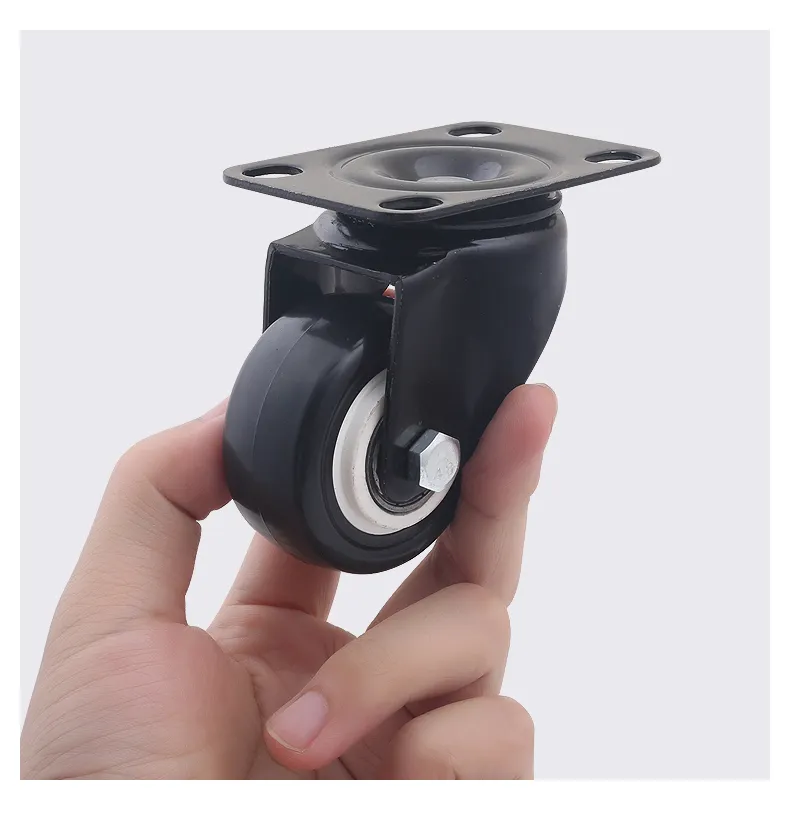
Ideal Applications: Light-duty casters find their ideal applications in various industries and scenarios where the loads being transported are relatively light and the mobility requirements are not overly demanding. Some common ideal applications include:
1. Retail Environments: Light duty casters are commonly used in retail settings, such as grocery stores, warehouses, and shops, where they facilitate the movement of display racks, carts, and shelves.
2. Office Furniture: They are well-suited for office furniture like rolling chairs, computer carts, and small mobile storage units.
3. Hospitality: Light-duty casters are often used in hotels and restaurants for movable service carts, luggage racks, and equipment trolleys.
4. Medical Facilities: In healthcare settings, light-duty casters are employed on medical carts, utility carts, and portable equipment stands.
5. Light Manufacturing: Light-duty casters can be used in light manufacturing environments for moving smaller components or light equipment.
Benefits and Limitations:
1. Advantages:
– Cost-Effective: Light-duty casters are generally more budget-friendly compared to heavier-duty options, making them an economical choice for applications with lighter load requirements.
– Easy Maneuverability: Due to their smaller size and lower weight capacity, light-duty casters offer excellent maneuverability, allowing for effortless movement in tight spaces and congested areas.
– Floor Protection: Light-duty casters with softer wheel materials, such as rubber or polyurethane, provide floor protection, preventing damage to delicate surfaces like hardwood or tile.
2. Limitations:
– Load Capacity: The primary limitation of light-duty casters is their restricted load capacity. They are not suitable for heavy loads, and using them beyond their capacity can lead to premature wear and reduced longevity.
– Durability: Light-duty casters are not as durable as heavy-duty or super heavy-duty casters. In high-impact or demanding environments, they may wear out faster, necessitating more frequent replacements.
– Limited Versatility: While they excel in specific applications, light-duty casters may not be suitable for more rigorous industrial settings that demand higher load capacities and robust performance.
In conclusion, light-duty casters serve as a practical and cost-effective solution for applications with lighter load requirements and lower mobility demands. They find widespread use in retail, office, hospitality, and healthcare industries, among others. However, it is essential to consider their load capacity limitations and ensure they are appropriately matched to the specific application to achieve optimal performance and longevity.
B. Medium Duty Casters:
Medium-duty casters are a type of industrial caster that falls between light-duty and heavy-duty options in terms of load capacity and construction. These casters are designed to handle moderately heavier loads compared to light-duty casters, typically ranging from around 300 to 1,000 pounds per caster. They strike a balance between durability and mobility, making them versatile choices for a wide range of applications.
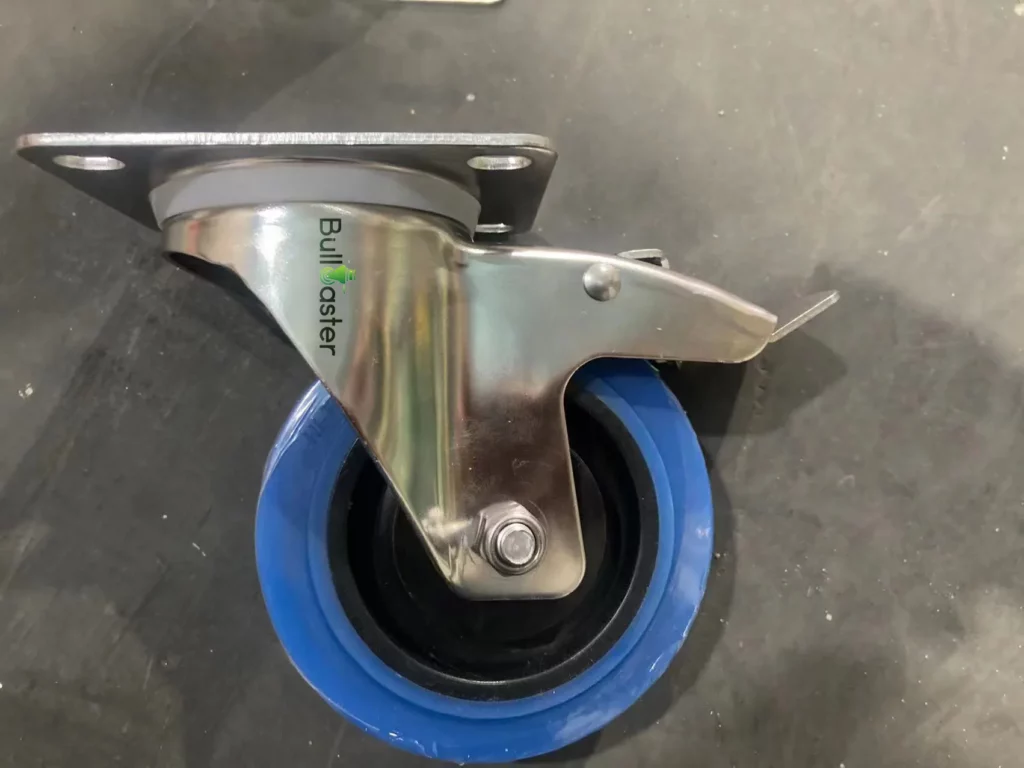
– Ideal Applications: Medium-duty casters are well-suited for industries and scenarios that require more robust performance and flexibility. Some ideal applications include:
1. Manufacturing: Medium-duty casters are commonly used in manufacturing settings for transporting components, tools, and workstations.
2. Warehousing and Distribution: They find applications in warehouses and distribution centers for moving pallets, carts, and material handling equipment.
3. Institutional Facilities: In schools, universities, and libraries, medium-duty casters are employed on book carts, AV equipment trolleys, and utility carts.
4. Automotive: In automotive repair shops and garages, medium-duty casters are used for rolling toolboxes, workbenches, and vehicle dollies.
5. Institutional Furniture: Medium-duty casters are found on furniture like mobile display units, utility tables, and movable seating.
– Benefits and Limitations:
1. Advantages:
– Increased Load Capacity: Medium-duty casters offer a substantial increase in load capacity compared to light-duty casters, making them suitable for a broader range of applications that require handling moderately heavier items.
– Enhanced Durability: These casters are designed with sturdier materials and components, providing better durability and performance in moderately demanding environments.
– Versatility: Medium-duty casters strike a balance between load capacity and mobility, making them versatile for various industries and applications that fall between light and heavy-duty requirements.
2. Limitations:
– Heavy Load Limit: While medium-duty casters can handle a considerable range of loads, they may not be suitable for extremely heavy or industrial-sized loads found in heavy manufacturing or construction settings.
– Higher Cost: Compared to light-duty casters, medium-duty casters may come at a higher cost due to their increased load capacity and enhanced durability.
– Specialized Applications: In scenarios where extremely heavy loads or high mobility demands are present, heavy-duty or super heavy-duty casters might be more suitable, leaving medium-duty casters as a compromise.
In conclusion, medium-duty casters provide a practical and versatile option for applications that require handling moderately heavier loads. Their ability to strike a balance between load capacity, durability, and mobility makes them popular in manufacturing, warehousing, institutional facilities, automotive, and more. However, it is essential to carefully assess the specific load requirements and application demands to determine whether medium-duty casters are the optimal choice for achieving efficient and reliable material handling solutions.
C. Heavy-Duty Casters:
Heavy-duty casters are robust and durable industrial casters designed to handle significantly heavier loads than medium and light-duty casters. They are engineered to support loads ranging from around 1,000 to 10,000 pounds per caster, making them the go-to choice for applications that involve moving large and cumbersome items with ease and stability.
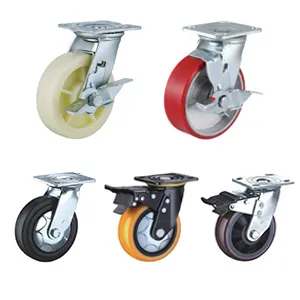
– Ideal Applications: Heavy-duty casters excel in industries and scenarios that demand the transportation of substantial and bulky loads. Their exceptional load-bearing capabilities make them indispensable in the following ideal applications:
1. Manufacturing and Construction: Heavy-duty casters are extensively used in manufacturing and construction settings, where they enable the smooth movement of heavy machinery, equipment, and materials.
2. Aerospace and Defense: In the aerospace and defense industries, heavy-duty casters are utilized for transporting aircraft components, missiles, and armored vehicles.
3. Logistics and Material Handling: Heavy-duty casters play a vital role in logistics and material handling operations, facilitating the movement of large crates, pallets, and heavy cargo.
4. Automotive and Transportation: In automotive assembly lines and transportation facilities, heavy-duty casters are employed for moving vehicles during production and maintenance.
5. Heavy-Duty Industrial Equipment: These casters are commonly found on heavy-duty racks, large-scale storage systems, and industrial-sized ovens or furnaces.
– Benefits and Limitations:
1. Advantages:
– Remarkable Load Capacity: The most significant advantage of heavy-duty casters is their ability to support extremely heavy loads, ensuring efficient and safe material handling of large items.
– Enhanced Durability: Heavy-duty casters are constructed with high-quality materials, such as heavy-gauge steel and robust wheel materials, to withstand the rigors of heavy industrial use and demanding environments.
– Stability and Safety: With their sturdy build and larger wheel diameter, heavy-duty casters provide enhanced stability and reduced risk of tipping, ensuring a safer working environment.
2. Limitations:
– Reduced Maneuverability: Due to their larger size and weight-bearing capabilities, heavy-duty casters might have slightly reduced maneuverability compared to their lighter counterparts. However, this limitation is outweighed by their load-carrying capacity.
– Higher Cost: Heavy-duty casters tend to be more expensive compared to light and medium-duty options due to their heavy-duty construction and materials.
– Flooring Consideration: The substantial weight carried by heavy-duty casters may require special consideration for the type and condition of the flooring to prevent damage.
In conclusion, heavy-duty casters are the workhorses of material handling, capable of handling large and heavy loads with ease and stability. Industries such as manufacturing, aerospace, logistics, and automotive heavily rely on these casters for their ability to transport substantial items efficiently and safely. Despite slightly reduced maneuverability and higher costs, the benefits of their remarkable load capacity and durability make heavy-duty casters a top choice for applications that demand rugged and reliable caster solutions.
D. Extra/Super Heavy Duty Casters:
Super heavy-duty casters are the pinnacle of industrial caster strength and load-bearing capabilities. These specialized casters are engineered to handle extremely heavy loads that go beyond what standard heavy-duty casters can accommodate. With unparalleled load-bearing capacities, super heavy-duty casters can support loads ranging from 10,000 to 30,000 pounds per caster, or even more in some cases. They are constructed using heavy-gauge materials and premium components to withstand the immense pressures of moving massive objects.
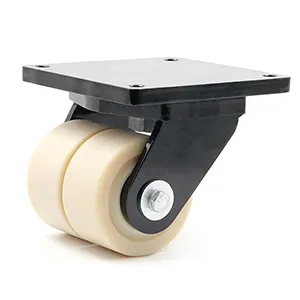
– Ideal Applications: Super heavy-duty casters are indispensable in industries and scenarios where the transportation of exceptionally heavy and bulky loads is required. Their unmatched load-bearing capabilities make them essential in the following ideal applications:
1. Heavy Machinery and Equipment: Industries dealing with heavy machinery and equipment, such as mining, construction, and oil and gas, rely on super heavy-duty casters for the movement of massive components.
2. Shipbuilding and Maritime: In shipyards and maritime facilities, these casters are utilized for transporting ship parts and equipment during construction and maintenance.
3. Power Generation: Super heavy-duty casters play a crucial role in power plants, enabling the mobility of large turbines, generators, and other power generation equipment.
4. Steel and Metal Fabrication: Steel mills and metal fabrication facilities benefit from super heavy-duty casters to transport heavy steel coils, beams, and other raw materials.
5. Aerospace and Defense: In the aerospace and defense industries, these casters are employed for moving large aircraft parts and military equipment.
– Benefits and Limitations:
1. Advantages:
– Unmatched Load Capacity: The most significant advantage of super heavy-duty casters is their unparalleled load-bearing capabilities, making them a reliable choice for handling the heaviest loads in industrial environments.
– Superior Durability: Super heavy-duty casters are built with rugged materials and components, ensuring they can endure the extreme demands of heavy-duty applications.
– Stability and Safety: Despite their colossal load capacity, these casters provide excellent stability and safety during material handling, thanks to their sturdy construction and large wheel diameter.
2. Limitations:
– Reduced Maneuverability: Due to their substantial size and weight, super heavy-duty casters may have limited maneuverability compared to lighter casters. However, in applications with colossal loads, maneuverability is often a secondary concern.
– Higher Cost: As expected, super heavy-duty casters come at a higher cost compared to other caster types, reflecting the specialized materials and construction required for handling such extreme loads.
– Floor Protection: The immense weight carried by super heavy-duty casters necessitates careful consideration of the flooring to prevent potential damage.
In conclusion, super heavy-duty casters are the epitome of strength and reliability in material handling. Industries dealing with exceptionally heavy loads, such as heavy machinery, shipbuilding, and power generation, depend on these casters to facilitate the movement of colossal objects. While they may come with higher costs and reduced maneuverability, the benefits of their unparalleled load capacity and durability make super heavy-duty casters an essential choice in critical industrial applications where nothing short of extraordinary strength will suffice.
Important Features and Components:
A. Wheel Materials:
When it comes to industrial casters, the choice of wheel material is a crucial consideration that directly impacts performance, floor protection, and load capacity. Different wheel materials offer unique properties that suit specific applications and environments. Here are some of the common wheel materials used in industrial casters and their respective characteristics:
– Description: Rubber wheels are a popular choice for industrial casters due to their excellent shock absorption and traction properties. They are made from various types of rubber, such as hard rubber, soft rubber, and thermoplastic rubber (TPR).
– Floor Protection: Rubber wheels provide exceptional floor protection, making them suitable for use on delicate surfaces like hardwood, tile, and epoxy-coated floors. The soft rubber variants are particularly gentle on floors, reducing the risk of damage or marks.
– Load Capacity: Rubber wheels typically offer a lower load capacity compared to other materials, making them more suitable for light to medium-duty applications.
– Description: Polyurethane wheels are known for their durability, abrasion resistance, and high load-bearing capabilities. They come in various hardness levels, from soft to hard, to suit different application requirements.
– Floor Protection: Polyurethane wheels provide excellent floor protection, especially on smooth and hard surfaces. They are less likely to leave marks or cause damage.
– Load Capacity: Polyurethane wheels can handle heavy loads efficiently, making them suitable for medium to heavy-duty applications.

– Description: Nylon wheels are tough and impact-resistant, making them ideal for demanding industrial environments. They are available in various formulations, including glass-filled nylon for added strength.
– Floor Protection: Nylon wheels are generally not recommended for delicate or smooth floors as they can cause scuffing or damage. They are better suited for rougher surfaces like concrete and outdoor terrains.
– Load Capacity: Nylon wheels offer excellent load capacity and are well-suited for heavy-duty applications where durability is essential.
– Description: Steel wheels are the toughest and most durable option among industrial caster wheel materials. They are often used in extreme environments with high temperatures or heavy impact.
– Floor Protection: Steel wheels are not suitable for use on most floors as they can cause damage and leave marks. They are commonly used in applications where floor protection is not a primary concern.
– Load Capacity: Steel wheels have exceptional load capacity and are used in heavy-duty applications where other materials may not withstand extreme conditions.
In conclusion, the choice of wheel material for industrial casters depends on the specific application’s requirements. Rubber wheels offer excellent floor protection but have lower load capacities, making them ideal for lighter tasks. Polyurethane wheels strike a good balance between floor protection and load capacity, suitable for medium to heavy-duty applications. Nylon wheels are tough and durable but not recommended for delicate floors. Steel wheels are the toughest and can handle extreme conditions but are not suitable for most floors. By understanding the properties of different wheel materials, one can select the most appropriate caster type for the intended application, ensuring optimal performance, floor protection, and load capacity.
B. Swivel vs. Rigid Casters:
When it comes to industrial casters, two primary types stand out: swivel casters and rigid casters. Each type serves a specific purpose and offers unique advantages, and understanding their differences is essential in creating efficient and versatile caster setups.
1. Swivel Casters:
– Description: Swivel casters are designed with a swiveling mechanism that allows the caster to rotate 360 degrees around a vertical axis. This enables smooth and easy directional changes, offering excellent maneuverability in any direction.
– Advantages:
– Maneuverability: Swivel casters provide unparalleled maneuverability, making them ideal for navigating tight spaces, congested areas, and around obstacles with ease.
– Versatility: Due to their ability to change direction, swivel casters offer flexibility in various setups, providing smooth movement and agile steering.
2. Rigid Casters:
– Description: Rigid casters, also known as fixed casters, do not have a swiveling mechanism. They move only in a straight line and provide stability and control in one direction.
– Advantages:
– Stability: Rigid casters offer excellent stability, ensuring that the caster moves in a predictable path without any lateral movement.
– Load Distribution: In setups with multiple casters, rigid casters can help evenly distribute the load, providing better weight distribution and reducing the strain on swivel casters.

When to Use Each Type and How They Complement Each Other:
1. Swivel Casters:
– Ideal Applications: Swivel casters are best suited for setups that require high maneuverability, such as carts, equipment trolleys, and furniture that needs to change direction frequently.
– Complementary Role: Swivel casters are often paired with rigid casters in setups to create what is known as a “caster configuration.” This combination allows for easy movement and directional changes while ensuring stability during straight-line motion.
2. Rigid Casters:
– Ideal Applications: Rigid casters are commonly used in conjunction with swivel casters to support heavier loads or to provide stability to caster configurations.
– Complementary Role: When used together, rigid casters help maintain the direction of movement in setups with swivel casters, preventing unintended drift or swiveling when the caster needs to move in a straight line.
Optimal Uses of Caster Configurations:
– 2 Swivel, 2 Rigid: This configuration provides excellent maneuverability and stability for applications like carts and dollies used in tight spaces. The swivel casters allow for easy direction changes, while the rigid casters offer stability during straight-line movement.
– 4 Swivel: This configuration is suitable for applications where maximum maneuverability is required, such as on mobile workstations, displays, and utility carts that need to navigate through narrow aisles or crowded areas.
– 2 Swivel with Total Lock, 2 Rigid: In this configuration, two swivel casters come with total lock brakes, allowing them to lock both the swivel and wheel rotation. This setup provides both maneuverability and stability when needed, making it suitable for heavy loads that require precise positioning.
In conclusion, swivel casters offer excellent maneuverability, while rigid casters provide stability in one direction. Using them together in various configurations allows for versatile and efficient movement in industrial applications. Selecting the appropriate caster type or configuration depends on the specific needs of the setup, load requirements, and the level of maneuverability and stability desired in the operation.
C. Caster Bearing Types:
Bearings are critical components in industrial casters that facilitate smooth movement by reducing friction between the caster’s wheel and its axle. They play a significant role in ensuring efficient and reliable caster performance. There are two primary bearing types commonly used in industrial casters:
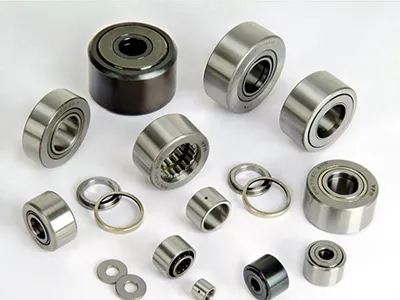
1. Roller Bearings:
– Description: Roller bearings consist of cylindrical rollers arranged between the inner and outer raceways. These rollers provide a large contact surface area, enabling the bearing to support heavy loads and distribute the weight evenly.
– Significance: Roller bearings are well-suited for heavy-duty applications where the caster needs to handle substantial loads. They offer superior load capacity and durability, making them ideal for challenging industrial environments.
2. Ball Bearings:
– Description: Ball bearings contain small metal balls held within the bearing’s inner and outer raceways. The rolling action of the balls reduces friction, allowing for smoother and more effortless rotation.
– Significance: Ball bearings are commonly used in lighter to medium-duty applications, where smooth and quiet operation is desired. They provide good load capacity while offering enhanced maneuverability and low rolling resistance, making them suitable for a wide range of industrial settings.
The Significance of Bearings in Smooth and Efficient Caster Performance:
1. Reduced Friction: Bearings significantly reduce friction between the caster’s wheel and axle, allowing for smoother rotation and movement. This reduces the effort required to push or pull the caster, making it easier to move heavy loads.
2. Load Distribution: Bearings help evenly distribute the load across the wheel’s surface, ensuring that the weight is well-supported and preventing excessive stress on specific points. This even distribution contributes to the caster’s stability and longevity.
3. Enhanced Maneuverability: The reduced friction provided by bearings improves the caster’s maneuverability, enabling it to move with minimal resistance and be more agile. This is especially important in applications where precise positioning and navigation are required.
4. Noise Reduction: The rolling action of bearings creates less noise during movement compared to other methods, contributing to a quieter working environment, which can be particularly beneficial in indoor or noise-sensitive settings.
5. Longevity and Durability: Bearings help reduce wear and tear on the caster’s components, increasing its overall lifespan. Properly maintained bearings result in a more durable caster that can withstand prolonged use in demanding industrial environments.
In conclusion, bearings are essential elements in industrial casters that enable smooth, efficient, and reliable movement. By reducing friction, evenly distributing the load, and enhancing maneuverability, bearings play a critical role in optimizing caster performance. Whether using roller bearings for heavy-duty applications or ball bearings for lighter tasks, selecting the appropriate bearing type ensures that the caster operates at its best, improving productivity and contributing to a safer and more productive industrial setting.
II. Factors to Consider When Choosing Industrial Casters
When it comes to selecting industrial casters, several crucial factors must be carefully considered to ensure optimal performance and safety. The choice of the right caster type goes beyond a one-size-fits-all approach and requires a thorough assessment of specific requirements in the industrial setting.
A. Load Capacity:
One of the most critical factors to consider when choosing industrial casters is their load capacity. Different caster types are designed to support varying weights, and exceeding the recommended load capacity can lead to premature wear and failure of the casters. It is essential to calculate the maximum weight that the casters will need to bear, taking into account not only the weight of the equipment but also the weight of the load it will transport. Opting for casters with a higher load capacity than required provides an additional safety margin and ensures long-lasting performance.
B. Flooring and Environment:
The type of flooring and the working environment are significant influencers in caster selection. For example, smooth and clean surfaces, such as concrete floors, may work well with most caster types. However, if the industrial setting involves rough or uneven terrain, outdoor use, or areas with debris and obstacles, the choice of the caster must be tailored to withstand such conditions.
– Hard Wheel Casters: Ideal for smooth and hard surfaces, these casters are durable and offer low rolling resistance, making them suitable for indoor use on concrete floors.
– Soft Wheel Casters: Suitable for rough and uneven surfaces, soft wheel casters provide better shock absorption and can handle debris or obstacles in their path. They are well-suited for outdoor or warehouse applications.
– Non-Marking Casters: In environments where floor protection is crucial, non-marking casters made of materials like rubber or polyurethane are preferred to prevent any damage or markings on the flooring.
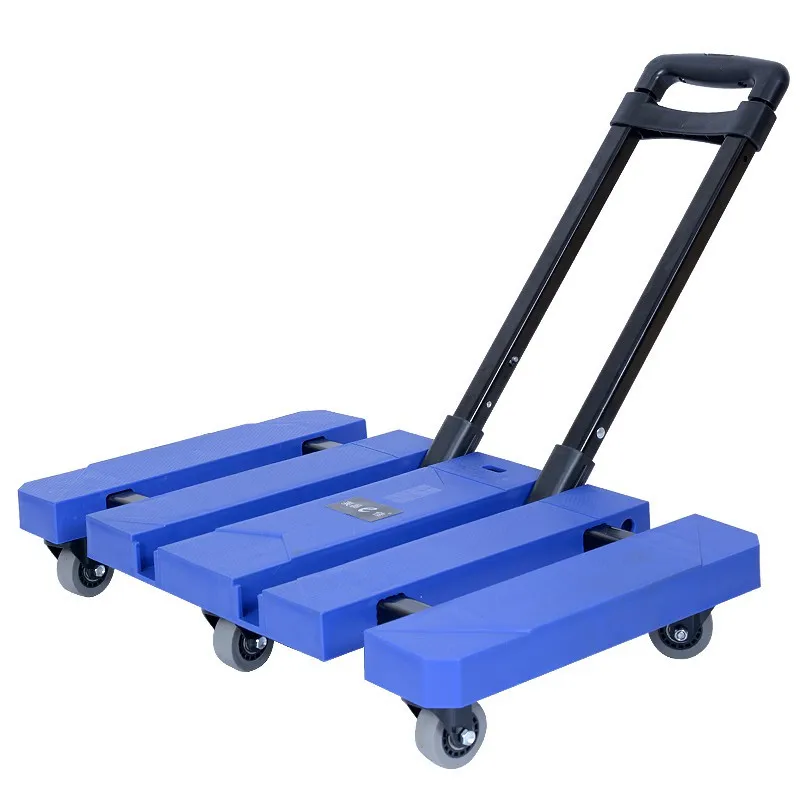
C. Maneuverability:
Efficient maneuverability is vital for industrial casters, especially in tight and congested spaces. The ability to move loads with ease around obstacles, corners, and tight corners enhances productivity and reduces the risk of accidents.
– Swivel Casters: These casters have a swiveling mechanism that allows them to rotate 360 degrees, enabling smooth directional changes and agile movement in any direction.
– Rigid Casters: Rigid casters move only in a straight line and do not swivel, offering stability and steering control in a specific direction. They are often paired with swivel casters to create more flexible caster setups.
D. Brake Systems:
Brake systems are critical for ensuring stability and safety during material handling tasks. Industrial casters may come with various brake options, including:
– Total Lock Brake: This type of brake locks both the swivel and wheel rotation, preventing any movement or rotation, and ensuring utmost stability when needed.
– Directional Lock Brake: These brakes lock the swivel rotation, allowing movement in a straight line while preventing sideways movement.
– Side Lock Brake: Side lock brakes restrict the movement of the swivel in one direction, providing controlled and stable steering.
Properly selected brake systems prevent unwanted movement during loading and unloading, especially on inclined surfaces or when stationary for extended periods, reducing the risk of accidents and injuries.
How Do I Maintain and Prolong the Lifespan of Industrial Casters?
Maintaining industrial casters is crucial to ensure their longevity and optimal performance. Additionally, implementing safety guidelines is essential to prevent accidents and injuries in the workplace. Here are some essential caster maintenance and safety tips:
A. Caster Maintenance Tips:
1. Regular Inspections: Conduct frequent visual inspections of the casters to check for signs of wear, damage, or loose components. Address any issues promptly to prevent further damage.
2. Lubrication: Ensure that the caster’s bearings and swivel mechanisms are properly lubricated. Regular lubrication reduces friction, extends the caster’s lifespan, and enhances its maneuverability.
3. Cleaning: Keep the casters clean and free from debris, dust, or grease buildup. Regular cleaning prevents contamination and maintains smooth movement.
4. Load Capacity: Adhere to the caster’s load capacity limits. Avoid overloading casters as it can lead to premature wear and potential failures.
5. Floor Compatibility: Choose the right caster wheel material that is compatible with the flooring in your workplace. This prevents damage to the floors and ensures smooth rolling.
6. Brake Maintenance: If the casters are equipped with brakes, check and adjust them regularly to ensure they are in proper working condition. Faulty brakes can lead to accidents and injuries.
B. Caster Safety Guidelines:
1. Training: Provide proper training to employees on the safe use of casters, including how to handle heavy loads, navigate obstacles, and maintain stability during movement.
2. Weight Distribution: Ensure that loads are evenly distributed on the casters. Imbalanced loads can cause instability and increase the risk of tipping.
3. Safe Speeds: Encourage employees to move casters at a safe and controlled speed, especially when carrying heavy or bulky loads.
4. Caution on Inclines: Use caution when navigating inclines or ramps. Apply brakes when needed to prevent unintended movement.
5. Proper Pathways: Keep pathways clear of obstacles and clutter to facilitate smooth and safe movement of casters.
6. Personal Protective Equipment (PPE): Provide appropriate PPE, such as gloves and safety shoes, to employees handling casters and heavy loads.
7. Locking Devices: Use locking devices when necessary to stabilize casters during loading, unloading, or when stationary for extended periods.
8. Avoid Sudden Stops: Avoid sudden stops and sharp turns, especially when carrying heavy loads. Sudden movements can lead to accidents and product damage.
9. Training for Emergency Situations: Train employees on how to handle emergencies involving casters, such as if a caster gets stuck or if a load becomes unstable.
10. Reporting Issues: Encourage employees to report any caster-related issues, malfunctions, or safety concerns promptly to the appropriate personnel.
By following these caster maintenance and safety tips, you can ensure that your industrial casters remain in good working condition, contribute to a safe working environment, and provide efficient material handling solutions. Regular maintenance and adherence to safety guidelines are essential for maximizing productivity, preventing accidents, and promoting the well-being of employees in the workplace.
Where to Buy High-Quality Industrial Casters?
Are you looking to purchase the best industrial caster wheels for your specific needs? With a comprehensive understanding of the various types available, selecting the perfect caster has never been easier. Depending on your requirements, you can opt for a medium-duty caster for everyday applications, a heavy-duty one for your shop floor, or even an extremely heavy-duty caster for factory operations. We cater to a wide range of customers, from small local shops to airplane manufacturing companies.
If you can’t find the exact caster you need among our extensive selection of high-quality industrial casters, worry not! We offer custom-made caster wheels tailored to your specific design requirements and purposes. Our team of skilled engineers will carefully analyze your needs and assemble all the critical components to create a functional caster that perfectly fulfills your specified requirements.

As a world-class caster wheel manufacturer, we take pride in offering a diverse range of casters, including those made of Polyurethane (PU), plastic, fixed or rigid, stem swivel, and more. Rest assured, you’ll find the ideal caster to meet your exclusive needs within our inventory. Our commitment to exceptional customer service is the cherry on top, ensuring your satisfaction throughout the buying process.
Don’t hesitate any longer – reach out to us for all your industrial caster needs. Whether you prefer a phone call or an inquiry, we are ready to assist you promptly and efficiently. Experience the convenience and reliability of our industrial casters today!
Frequently Asked Questions About Industrial Casters
Yes, Industrial casters can be used outdoors, but their performance on rough terrain depends on factors like caster type, wheel material, size, load capacity, swivel mechanism, maintenance, and obstacle clearance. Wheels made of hard rubber, polyurethane, or pneumatic tires perform better on rough surfaces. Larger wheels with higher load capacities provide stability and reduce the impact of obstacles. Regular maintenance is crucial for optimal performance. Choose appropriate casters for specific outdoor conditions to ensure smooth movement and longevity.
To choose the right industrial caster for your application:
Consider the load capacity and wheel material.
Choose an appropriate wheel size for stability.
Decide between the swivel and fixed casters.
You can check our previous article to learn more about how to choose casters according to application scenarios.
Different casters have different applicable scenarios, please refer to our previous article on the introduction of various caster materials.
Yes, there are special casters for high-temperature use scenarios, such as high-heat nylon casters, phenolic casters, silicone casters, metal casters, etc., you can check our high-temperature resistant caster wheel series.
Conclusion
Industrial casters play a pivotal role in material handling and mobility across various industries. From retail environments to heavy manufacturing, these essential components enable the smooth movement of equipment, furniture, and goods, improving efficiency and productivity in the workplace. The significance of industrial casters cannot be overstated, as they contribute to reduced manual effort, enhanced maneuverability, and increased safety in industrial settings.
Selecting the appropriate caster type is paramount in ensuring optimal performance and longevity. Light-duty casters are cost-effective and ideal for lighter loads, while medium-duty casters strike a balance between capacity and mobility. Heavy-duty and super heavy-duty casters excel in handling substantial loads in demanding environments. Additionally, considering the wheel material and bearing type is essential to protect flooring, enhance maneuverability, and reduce friction for smoother movement.
Each application has unique requirements, and taking these factors into account when choosing industrial casters is crucial. Oversized or undersized casters, as well as inappropriate wheel materials, can lead to premature wear, decreased efficiency, and potential safety hazards. It is vital for readers to carefully assess their specific needs and seek expert advice when necessary.
Bullcaster is an experienced caster manufacturer, you can contact us for a quotation and parameters of any caster.


